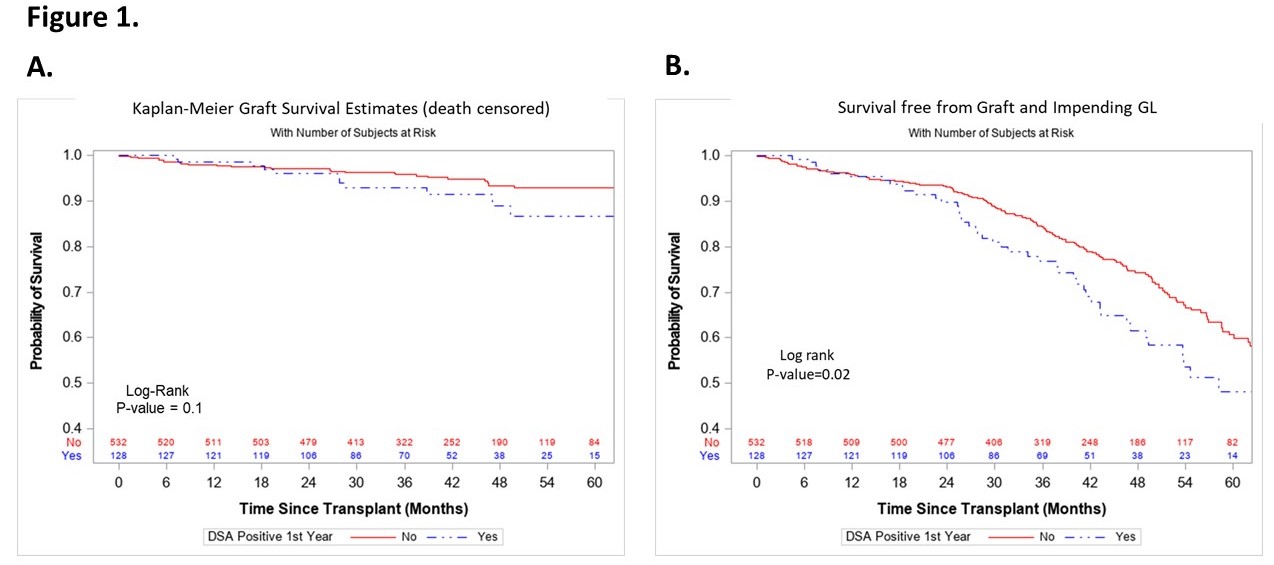The Impact of DSA Screening in Stable Kidney Transplant Recipients in the 1st Year Post-Transplant
1Thomas E. Starzl Transplant Institute, Renal Electrolyte Division, University of Pittsburgh Medical Center, Pittsburgh, PA, 2Thomas E. Starzl Transplant Institute, University of Pittsburgh Medical Center, Pittsburgh, PA
Meeting: 2020 American Transplant Congress
Abstract number: 619
Keywords: HLA antibodies, Kidney transplantation, Protocol biopsy, Screening
Session Information
Session Name: Biomarkers, Immune Assessment and Clinical Outcomes VI
Session Type: Oral Abstract Session
Date: Saturday, May 30, 2020
Session Time: 3:15pm-4:45pm
 Presentation Time: 3:39pm-3:51pm
Presentation Time: 3:39pm-3:51pm
Location: Virtual
*Purpose: The importance of Donor Specific Antibody (DSA) as a screening tool within the 1st year post kidney transplant in stable patients remains unclear. We studied the impact of DSA detection among stable kidney transplant recipients during the 1st year on clinical outcomes.
*Methods: 751 patients (pts) from 2014-2017 with kidney transplant alone were studied (ABO compatible, Flow cross match negative). 13 pts were excluded for early graft loss and 78 pts were excluded for clinical rejection w/in 1st year (T Cell or Antibody Mediated). The remaining 660 pts were grouped into DSA+ (≥ 1 positive test above designated MFI threshold, Class I or II, n=128) or DSA- (<1 positive test, n=532). DSA testing was done @ 1, 3, 6, 9, & 12 months per protocol. Biopsies (protocol 3 & 12 months) were included. Outcomes measured were sub-clinical inflammation (SCI) & sub-clinical rejection (SCR), chronicity at 1 year (interstitial fibrosis/tubular atrophy, IFTA), graft function, graft survival, and composite of graft loss & impending graft loss (eGFR < 30 ml/min & > 30% decline from 3 mos to last follow up).
*Results: DSA was detected in 19% of stable recipients during the 1st year post transplant. DSA+ pts were similar to DSA- pts in baseline/transplant characteristics, other than being younger (50 vs 53, p=0.007) and more sensitized (% with cPRA > 20%, 59% vs 40%, p<0.001). DSA+ pts had 45% Class I only, 44% Class II only, and 14% with both Class I/II. Beyond 1 year, DSA- pts developed DSA in 11% of pts. DSA+ pts did not have more SCI or SCR (TCMR or ABMR) than DSA- pts (46% vs 40%, 24% vs 32%, p=ns). Further, there was no difference in median IFTA scores @ 1 year, graft function (eGFR), or death censored graft survival among DSA+ vs DSA- pts. However, a lower composite outcome (eGFR < 30 ml/min & > 30% decline from 3 mos to last follow up) was noted in DSA+ pts vs DSA- pts (p=0.02, Figure 1).
*Conclusions: Stable pts with DSA detection using a screening protocol during the 1st year post-transplant had similar short-term outcomes, including incidence of SCI or SCR, than those without DSA detected. DSA+ pts had similar long-term graft function and survival, though a lower composite outcome compared to DSA- pts. Thus, DSA as a screening tool during the 1st year in stable kidney transplant recipients appears limited in risk stratifying patients based on early post-transplant outcomes and utility in risk stratifying for late outcomes remains uncertain.
To cite this abstract in AMA style:
Sharma A, Jorgensen D, Mehta R, Sood P, Wu C, Puttarajappa CM, Tevar A, Hariharan S. The Impact of DSA Screening in Stable Kidney Transplant Recipients in the 1st Year Post-Transplant [abstract]. Am J Transplant. 2020; 20 (suppl 3). https://atcmeetingabstracts.com/abstract/the-impact-of-dsa-screening-in-stable-kidney-transplant-recipients-in-the-1st-year-post-transplant/. Accessed December 25, 2025.« Back to 2020 American Transplant Congress

